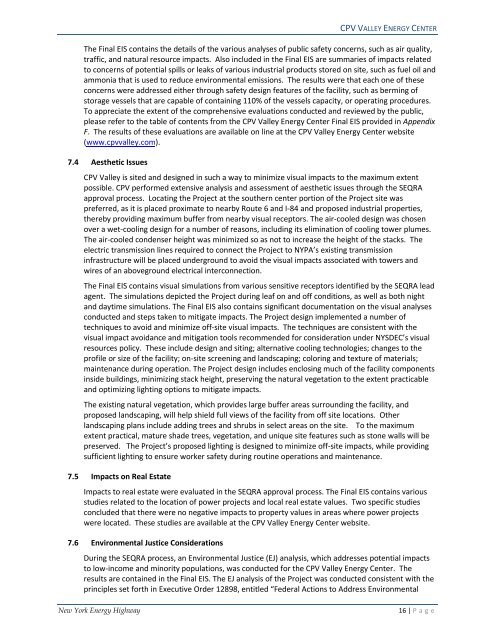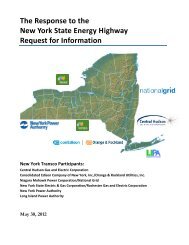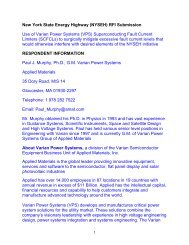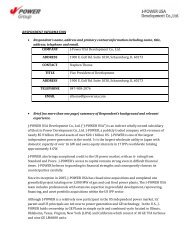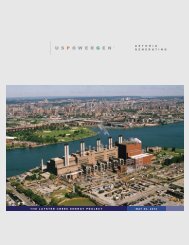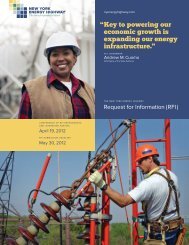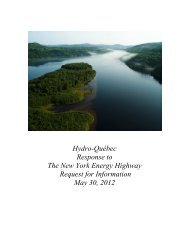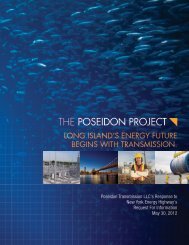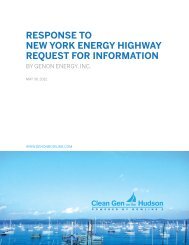Competitive Power Ventures, Inc. - Energy Highway
Competitive Power Ventures, Inc. - Energy Highway
Competitive Power Ventures, Inc. - Energy Highway
You also want an ePaper? Increase the reach of your titles
YUMPU automatically turns print PDFs into web optimized ePapers that Google loves.
CPV VALLEY ENERGY CENTER<br />
The Final EIS contains the details of the various analyses of public safety concerns, such as air quality,<br />
traffic, and natural resource impacts. Also included in the Final EIS are summaries of impacts related<br />
to concerns of potential spills or leaks of various industrial products stored on site, such as fuel oil and<br />
ammonia that is used to reduce environmental emissions. The results were that each one of these<br />
concerns were addressed either through safety design features of the facility, such as berming of<br />
storage vessels that are capable of containing 110% of the vessels capacity, or operating procedures.<br />
To appreciate the extent of the comprehensive evaluations conducted and reviewed by the public,<br />
please refer to the table of contents from the CPV Valley <strong>Energy</strong> Center Final EIS provided in Appendix<br />
F. The results of these evaluations are available on line at the CPV Valley <strong>Energy</strong> Center website<br />
(www.cpvvalley.com).<br />
7.4 Aesthetic Issues<br />
CPV Valley is sited and designed in such a way to minimize visual impacts to the maximum extent<br />
possible. CPV performed extensive analysis and assessment of aesthetic issues through the SEQRA<br />
approval process. Locating the Project at the southern center portion of the Project site was<br />
preferred, as it is placed proximate to nearby Route 6 and I-84 and proposed industrial properties,<br />
thereby providing maximum buffer from nearby visual receptors. The air-cooled design was chosen<br />
over a wet-cooling design for a number of reasons, including its elimination of cooling tower plumes.<br />
The air-cooled condenser height was minimized so as not to increase the height of the stacks. The<br />
electric transmission lines required to connect the Project to NYPA’s existing transmission<br />
infrastructure will be placed underground to avoid the visual impacts associated with towers and<br />
wires of an aboveground electrical interconnection.<br />
The Final EIS contains visual simulations from various sensitive receptors identified by the SEQRA lead<br />
agent. The simulations depicted the Project during leaf on and off conditions, as well as both night<br />
and daytime simulations. The Final EIS also contains significant documentation on the visual analyses<br />
conducted and steps taken to mitigate impacts. The Project design implemented a number of<br />
techniques to avoid and minimize off-site visual impacts. The techniques are consistent with the<br />
visual impact avoidance and mitigation tools recommended for consideration under NYSDEC’s visual<br />
resources policy. These include design and siting; alternative cooling technologies; changes to the<br />
profile or size of the facility; on-site screening and landscaping; coloring and texture of materials;<br />
maintenance during operation. The Project design includes enclosing much of the facility components<br />
inside buildings, minimizing stack height, preserving the natural vegetation to the extent practicable<br />
and optimizing lighting options to mitigate impacts.<br />
The existing natural vegetation, which provides large buffer areas surrounding the facility, and<br />
proposed landscaping, will help shield full views of the facility from off site locations. Other<br />
landscaping plans include adding trees and shrubs in select areas on the site. To the maximum<br />
extent practical, mature shade trees, vegetation, and unique site features such as stone walls will be<br />
preserved. The Project’s proposed lighting is designed to minimize off-site impacts, while providing<br />
sufficient lighting to ensure worker safety during routine operations and maintenance.<br />
7.5 Impacts on Real Estate<br />
Impacts to real estate were evaluated in the SEQRA approval process. The Final EIS contains various<br />
studies related to the location of power projects and local real estate values. Two specific studies<br />
concluded that there were no negative impacts to property values in areas where power projects<br />
were located. These studies are available at the CPV Valley <strong>Energy</strong> Center website.<br />
7.6 Environmental Justice Considerations<br />
During the SEQRA process, an Environmental Justice (EJ) analysis, which addresses potential impacts<br />
to low-income and minority populations, was conducted for the CPV Valley <strong>Energy</strong> Center. The<br />
results are contained in the Final EIS. The EJ analysis of the Project was conducted consistent with the<br />
principles set forth in Executive Order 12898, entitled “Federal Actions to Address Environmental<br />
New York <strong>Energy</strong> <strong>Highway</strong><br />
16 | P age


